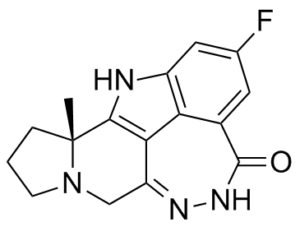This product is for research use only, not for human use. We do not sell to patients.

| Size | Price | Stock |
|---|---|---|
| 5mg | $150 | 3-6 Days |
| 10mg | $250 | 3-6 Days |
| 25mg | $450 | 3-6 Days |
| 50mg | $750 | 3-6 Days |
| 100mg | $1250 | 3-6 Days |
| 250mg | $1850 | 3-6 Days |
Cat #: V3280 CAS #: 1446261-44-4 Purity ≥ 98%
Description: Pamiparib (also known as BGB-290; trade name in China: Baihuize) is a novel, potent and selective inhibitor of PARP1/2 approved in China for cancer treatment. It inhibits PARP1/2 with IC50 values of 0.83 and 0.11 nM, respectively in enzymatic assays. It kills tumor cells via the so-called synthetic lethality. Pamiparib diaplays high selectivity over other PARP enzymes. It has good DMPK (Drug metabolism and pharmacokinetic) profiles. Pamiparib selectively binds to PARP and prevents PARP-mediated repair of single-strand DNA breaks via the base-excision repair (BER) pathway which enhances the accumulation of DNA strand breaks, promotes genomic instability, and eventually leads to apoptosis. Pamiparib can potentiate the cytotoxicity of DNA-damaging agents and reverse the chemo- and radioresistance of tumor cells.
Publications Citing InvivoChem Products
Product Promise

- Physicochemical and Storage Information
- Protocol
- Related Biological Data
- Stock Solution Preparation
- Quality Control Documentation
| Molecular Weight (MW) | 298.31 |
|---|---|
| Molecular Formula | C16H15FN4O |
| CAS No. | 1446261-44-4 |
| Storage | -20℃ for 3 years in powder form |
| -80℃ for 2 years in solvent | |
| Solubility In Vitro | DMSO: 60 mg/mL |
| Water: <1mg/mL | |
| Ethanol: >40 mg/mL | |
| SMILES Code | O=C1NN=C2CN(CCC3)[C@@]3(C)C(N4)=C2C5=C4C=C(F)C=C51 |
| Synonyms | BGB-290; BGB 290; BGB290 |
| Protocol | In Vitro | In vitro activity: Pamiparib (also known as BGB-290) is a novel, potent and selective inhibitor of PARP1 and PARP2 with IC50 values of 0.83 and 0.11 nM, respectively in enzymatic assays. Pamiparib diaplays high selectivity over other PARP enzymes. It has good DMPK (Drug metabolism and pharmacokinetic) profiles. Pamiparib selectively binds to PARP and prevents PARP-mediated repair of single-strand DNA breaks via the base-excision repair (BER) pathway which enhances the accumulation of DNA strand breaks, promotes genomic instability, and eventually leads to apoptosis. Pamiparib can potentiate the cytotoxicity of DNA-damaging agents and reverse the chemo- and radioresistance of tumor cells. Pamiparib is currently under clinical investigation and has the potential to be used for the treatment of various cancers including the solid tumor. Kinase Assay: In the biochemical assays, BGB-290 demonstrated great potency for PARP1/2 (IC50 = 0.83 and 0.11 nM, respectively) and high selectivity over other PARP enzymes. The DNA-trapping activity of BGB-290 was measured in a fluorescence polarization (FP) binding assay. BGB-290 showed potent DNA-trapping activity with IC50 of 13 nM. In the cellular assays, BGB-290 inhibited intracellular PAR formation with an IC50 of 0.24 nM. Tumor cell lines with homologous recombination defects were profoundly sensitive to BGB-290. Oral administration of BGB-290 resulted in time-dependent and dose-dependent inhibition of PARylation in MDA-MB-436 (BRCA1 mutant) breast cancer xenograft, correlating well with the tumor drug concentrations. Compared to olaparib, BGB-290 induced PAR inhibition was more sustained. Consistent with this finding, BGB-290 demonstrated excellent anti-tumor activity in this model, over 10-fold more potent than olaparib. Cell Assay: In a panel of 7 SCLC cell lines tested, 3 of them were sensitive to BGB-290. SCLC primary tumor models were established in house using patient biopsy samples obtained from Beijing Cancer Hospital. The anti-tumor activities of BGB-290 as single agent or in combination with etoposide/carboplatin (E/C) were evaluated in 8 SCLC primary tumor models. BGB-290 showed weak single agent activity in these models. Six of the 8 models (75%) were sensitive to E/C treatment, consistent with the clinical response observed in these patients. Addition of BGB-290 as concomitant treatment or maintenance therapy significantly prolonged the response duration in these chemo-sensitive models. In the two chemo-insensitive models, BGB-290 and E/C combo was less effective. Addition of BGB-290 to the chemo regiment was well-tolerated throughout the study. |
|---|---|---|
| In Vivo | The anti-tumor activities of BGB-290 as single agent or in combination with etoposide/carboplatin (E/C) were evaluated in 8 SCLC primary tumor models. BGB-290 showed weak single agent activity in these models. Six of the 8 models (75%) were sensitive to E/C treatment, consistent with the clinical response observed in these patients. Addition of BGB-290 as concomitant treatment or maintenance therapy significantly prolonged the response duration in these chemo-sensitive models. In the two chemo-insensitive models, BGB-290 and E/C combo was less effective. Addition of BGB-290 to the chemo regiment was well-tolerated throughout the study. | |
| Animal model | 8 SCLC primary tumor models. |
| Solvent volume to be added | Mass (the weight of a compound) | |||
|---|---|---|---|---|
| Mother liquor concentration | 1mg | 5mg | 10mg | 20mg |
| 1mM | 3.3522 mL | 16.7611 mL | 33.5222 mL | 67.0443 mL |
| 5mM | 0.6704 mL | 3.3522 mL | 6.7044 mL | 13.4089 mL |
| 10mM | 0.3352 mL | 1.6761 mL | 3.3522 mL | 6.7044 mL |
| 20mM | 0.1676 mL | 0.8381 mL | 1.6761 mL | 3.3522 mL |
This equation is commonly abbreviated as: C1 V1 = C2 V2
- (1) Please be sure that the solution is clear before the addition of next solvent. Dissolution methods like vortex, ultrasound or warming and heat may be used to aid dissolving.
- (2) Be sure to add the solvent(s) in order.




































